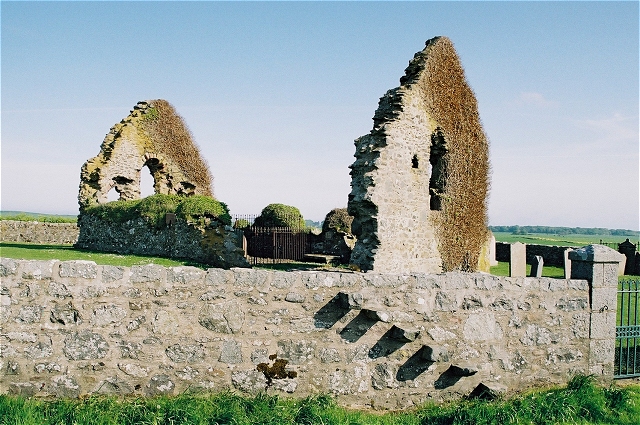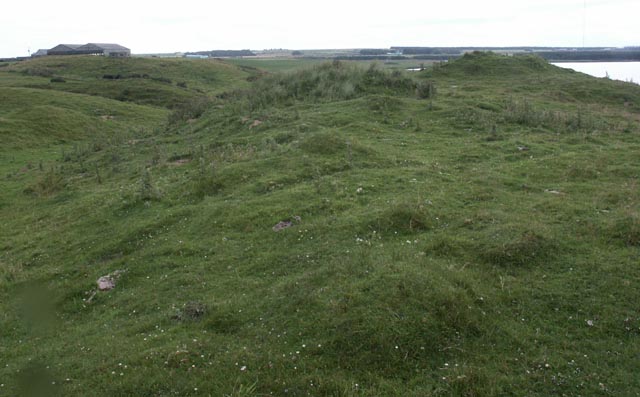|
Rattray, Aberdeenshire
Rattray (historic: Rettre; occasionally: Rattery; Scottish Gaelic: ''Raitear''), ''(found at )'' had been settled as far back as 4000 BC and was named a Royal Burgh in 1564 by Mary, Queen of Scots, "to put an end to the disputes about superiority over it between William Keith, 4th Earl Marischal and George Hay, 7th Earl of Erroll". The ancient burgh was located near to Crimond, but the village was largely destroyed and never recovered after a storm in the 18th century that covered it in shifting sands from the nearby dunes at Rattray Head. However, there is still a small modern settlement in the area. Features The nearby lagoon, ''Strathbeg Bay (also known as Strathbeg Water or Water of Rattray)'', had been an "open estuary which was navigable to trading ships" suiting itself to ''Starny Keppie'' harbour around which Rattray flourished. However, by 1654, the harbour was silting up badly and was finally cut off when shifting sands during a massive 1720 storm cut off the lagoon ... [...More Info...] [...Related Items...] OR: [Wikipedia] [Google] [Baidu] |
Castle Of Rattray
The Castle of Rattray was a medieval Scottish castle, with multiple variations on its structure over approximately six centuries. Originally built as a ''"late 12th- or early 13th century defensive motte"'' it provided protection for Starny Keppie Harbour and Rattray village. Sometime between 1214 and 1233 it was upgraded by William Comyn, jure uxoris Earl of Buchan before being destroyed in the 1308 Harrying of Buchan. After Comyn's timber castle was burned down, it was replaced by a stronger stone castle which was engulfed during a 1720 sand storm along with nearby Rattray village. After the storm, the castle was not dug out and remains covered to this day. The castle was described by W. Douglas Simpson as one of the nine castles of the Knuckle, referring to the rocky headland of north-east Aberdeenshire. Location The castle was sited on Castlehill, on the south bank of the now-closed estuary flowing into Strathbeg Bay- the north bank was protected by the opposite Lon ... [...More Info...] [...Related Items...] OR: [Wikipedia] [Google] [Baidu] |
HMS Merganser
Royal Navy Air Station Rattray or RNAS Rattray (HMS ''Merganser'') and also known as Crimond Airfield, Crimond Aerodrome or Rattray Aerodrome was a Royal Naval Air Station near Crimond, Aberdeenshire. History The station started to be built from March 1943, with 774 Naval Air Squadron moving in from July 1943 for Telegraphist Air Gunners training but the site was not commissioned until 3 October 1944. The base then switched to training Torpedo Bombing Reconnaissance crews. The following units were here at some point: * 708 Naval Air Squadron: * 714 Naval Air Squadron (May 1944-unknown) * 717 Naval Air Squadron (November 1944-unknown) * 753 Naval Air Squadron * 766 Naval Air Squadron * 769 Naval Air Squadron * 774 Naval Air Squadron (July 1943-August 1945) * 815 Naval Air Squadron * 817 Naval Air Squadron * 818 Naval Air Squadron * 821 Naval Air Squadron * 825 Naval Air Squadron The base was closed in 1946, being moved into a state of care & maintenance. It was also use ... [...More Info...] [...Related Items...] OR: [Wikipedia] [Google] [Baidu] |
Sir James The Rose
Sir James the Rose is Child ballad 213. It was published as a broadside ballad. Synopsis The broadside opens with the account of Sir James the Rose's love for a lady named Matilda, how her family tried to marry her off, and how he killed her brother for spying on them. Child's version merely opens with the news that Sir James the Rose killed a squire and asked his lover to hide him. In both versions, the woman tells him where to spend the night and eventually betrays him to those seeking to avenge the death. James is killed, and she, full of remorse for her deed, dies of grief. See also * The Duke of Athole's Nurse Versions * Steeleye Span Steeleye Span are a British folk rock band formed in 1969 in England by Fairport Convention bass player Ashley Hutchings and established London folk club duo Tim Hart and Maddy Prior. The band were part of the 1970s British folk revival, and we ... recorded a version of this song on the album ''Rocket Cottage''. It can also be found o ... [...More Info...] [...Related Items...] OR: [Wikipedia] [Google] [Baidu] |
Morthouse
A morthouse or deadhouse was a specialised secure building usually located in a churchyard where bodies were temporarily interred before a formal funeral took place. These buildings date back to the time when bodysnatchers or resurrectionists frequently illegally exhumed dead bodies that were then sold for dissection as part of human anatomy training at universities, etc. Morthouses were alternatives to mortsafes, watch houses, watch towers, etc. A morthouse differs from a mortuary or morgue, which is a facility for the storage of human corpses awaiting identification or autopsy prior to burial. Graveyard security The Christian tradition at the time was that resurrection after death and entry into the afterlife required the body of the deceased to be whole at burial so that person could enter the kingdom of Heaven for eternal life complete in body and soul. The dissection of the corpses of hanged criminals was viewed in this context as part of the punishment. The level of securi ... [...More Info...] [...Related Items...] OR: [Wikipedia] [Google] [Baidu] |
Bellcote
A bellcote, bell-cote or bell-cot is a small framework and shelter for one or more bells. Bellcotes are most common in church architecture but are also seen on institutions such as schools. The bellcote may be carried on brackets projecting from a wall or built on the roof of chapels or churches that have no towers. The bellcote often holds the Sanctus bell that is rung at the consecration of the Eucharist. The bellcote is mentioned throughout history books when referring to older structures and communities. ''Bromsgrove church: its history and antiquities'' is one example which goes into depth about the construction and maintenance of the bellcoteBellcotes are also discussed in The Wiltshire Archæological and Natural History MagazineVolume 8anProceedings of the Somersetshire Archaeological and Natural ..., Volume 29 Etymology ''Bellcote'' is a compound noun of the words ''bell'' and ''cot'' or ''cote''. Bell#Etymology, ''Bell'' is self-explanatory. The word ''cot'' or ''cot ... [...More Info...] [...Related Items...] OR: [Wikipedia] [Google] [Baidu] |
James Matthews (architect)
James Matthews (December 1819 – 28 June 1898) was a prominent 19th-century architect in northern Scotland who also served as Lord Provost of Aberdeen from 1883 to 1886 during which time he enacted an important city improvement plan. His work as an architect is largely in the Scots baronial style. Life He was born in December 1819, the son of Peter Matthews, a bank teller, living on Thistle Street in Aberdeen. His mother was Margaret Ross, daughter of the architect William Ross who had built the Union Bridge in the centre of the city. In 1834 he was articled to the local architect, Archibald Simpson to train as an architect. Here he met Thomas MacKenzie (1814-1854) whom he later went into partnership with. In 1839 he took the radical step of moving to London to work under George Gilbert Scott where he honed his design and business skills. Returning to Aberdeen in 1844 Simpson offered him a partnership but he instead set up with his assistant to create MacKenzie & Matth ... [...More Info...] [...Related Items...] OR: [Wikipedia] [Google] [Baidu] |
St Mary's Chapel, Rattray
St Mary's Chapel (known also as "the Chapel of the Blessed Virgin") is a late 12th/early 13th century chapel found in Rattray, Aberdeenshire, Scotland. It was built by William Comyn, jure uxoris Earl of Buchan during the same period as the Castle of Rattray and was ''"private chapel for the castle"'' and its residents. ''"Dedicated to the Virgin Mary"'' it was possibly constructed after the ''"drowning of a"...'' nknown''"son of Comyn in the well near by."'' There is some controversy as to the date of the chapel's construction. There is a wall plaque with the date 911, but this is certainly a fake as the style of the church and its windows did not appear in Scotland until the late 12th century, which coincides with an account that states it ''"probably dates back to the late 1100s."'' William Comyn did not inherit the Earldom of Buchan until 1212, so the chapel's construction almost certainly did not begin prior to this date. William Comyn is recorded as giving the chapel ''"a ... [...More Info...] [...Related Items...] OR: [Wikipedia] [Google] [Baidu] |
Lonmay Castle
The remains of the Castle of Lonmay are found near Netherton of Lonmay, to the north of Loch Strathbeg in Buchan, Scotland. The remains are not located in the modern village of Lonmay which is approximately 6 km to the south-west. It was described by W. Douglas Simpson as one of the nine castles of the Knuckle, referring to the rocky headland of North-East Aberdeenshire. Dating from the 13th century it was home to the Clan Fraser, Fraser family. The castle ''"may have been a motte".'' It has long ceased to be in existence and there are very few remains to be found, all of which are buried under constantly shifting sand dunes that have over time engulfed the site. The castle provided protection to the north shore of the estuary that used to flow into Strathbeg Bay, before it closed off forming Loch Strathbeg around 1720. The south-shore (with Starny Keppie harbour and the village of Rattray, Aberdeenshire, Rattray) was protected by the Castle of Rattray. The remains are found ... [...More Info...] [...Related Items...] OR: [Wikipedia] [Google] [Baidu] |
The Nine Castles Of Knuckle
The nine castles of the Knuckle are a group of ancient castles found in Aberdeenshire in the Buchan area of Scotland. The term was used by historian William Douglas Simpson, who described the promontory between the Moray Firth and the North Sea as "the north-eastern knuckle The knuckles are the joints of the fingers. The word is cognate to similar words in other Germanic languages, such as the Dutch "knokkel" (knuckle) or German "Knöchel" (ankle), i.e., ''Knöchlein'', the diminutive of the German word for bone (' ... of Scotland". From west to east, the castles are Dundarg, Pitsligo, Pitullie, Kinnaird, Wine Tower, Cairnbulg, Inverallochy, Lonmay and Rattray. Although Simpson coined the term, he did not draw any connections between the sites, other than their location. References {{DEFAULTSORT:Knuckle, Nine Castles of Castles in Aberdeenshire ... [...More Info...] [...Related Items...] OR: [Wikipedia] [Google] [Baidu] |
Loch Strathbeg
The Loch of Strathbeg (also known as Loch Strathbeg; ''historically "Strathbeg Water"; "Water of Strathbeg"; "Rattray Water" or "Water of Rattray"'') is a designated Special Protection Area for wildlife conservation purposes. It is located near to Rattray and Crimond in Aberdeenshire, Scotland. The loch is maintained by the RSPB and around the loch there are three hides from which visitors may watch the birds and other wildlife. Access to the loch is through Crimond airfield where there is a car park at the edge of the reserve. There is also the 'Starnafin Centre' from which visitors may also watch the birds from and find out more information about which birds and animals are present locally. The RSPB has recorded over 260 species of bird, 280 species of insect and 26 species of mammal at the reserve. Formation The loch is a very recent creation of geological times, forming naturally in a massive storm in 1720. The lagoon, where the loch is now, its small harbour ''Starny ... [...More Info...] [...Related Items...] OR: [Wikipedia] [Google] [Baidu] |


